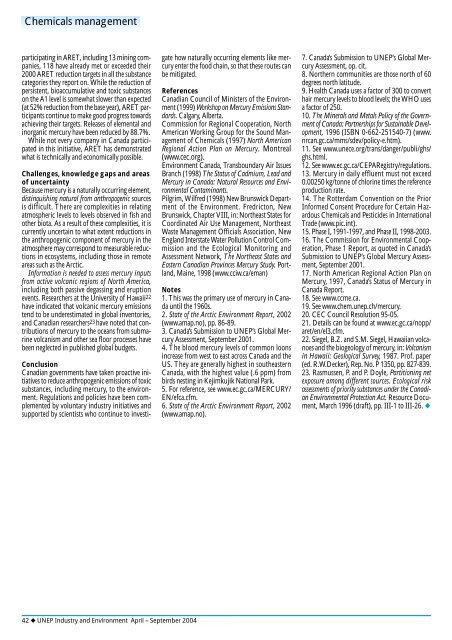industry and environment - DTIE
industry and environment - DTIE
industry and environment - DTIE
Create successful ePaper yourself
Turn your PDF publications into a flip-book with our unique Google optimized e-Paper software.
Chemicals management<br />
participating in ARET, including 13 mining companies,<br />
118 have already met or exceeded their<br />
2000 ARET reduction targets in all the substance<br />
categories they report on. While the reduction of<br />
persistent, bioaccumulative <strong>and</strong> toxic substances<br />
on the A1 level is somewhat slower than expected<br />
(at 52% reduction from the base year), ARET participants<br />
continue to make good progress towards<br />
achieving their targets. Releases of elemental <strong>and</strong><br />
inorganic mercury have been reduced by 88.7%.<br />
While not every company in Canada participated<br />
in this initiative, ARET has demonstrated<br />
what is technically <strong>and</strong> economically possible.<br />
Challenges, knowledge gaps <strong>and</strong> areas<br />
of uncertainty<br />
Because mercury is a naturally occurring element,<br />
distinguishing natural from anthropogenic sources<br />
is difficult. There are complexities in relating<br />
atmospheric levels to levels observed in fish <strong>and</strong><br />
other biota. As a result of these complexities, it is<br />
currently uncertain to what extent reductions in<br />
the anthropogenic component of mercury in the<br />
atmosphere may correspond to measurable reductions<br />
in ecosystems, including those in remote<br />
areas such as the Arctic.<br />
Information is needed to assess mercury inputs<br />
from active volcanic regions of North America,<br />
including both passive degassing <strong>and</strong> eruption<br />
events. Researchers at the University of Hawaii 22<br />
have indicated that volcanic mercury emissions<br />
tend to be underestimated in global inventories,<br />
<strong>and</strong> Canadian researchers 23 have noted that contributions<br />
of mercury to the oceans from submarine<br />
volcanism <strong>and</strong> other sea floor processes have<br />
been neglected in published global budgets.<br />
Conclusion<br />
Canadian governments have taken proactive initiatives<br />
to reduce anthropogenic emissions of toxic<br />
substances, including mercury, to the <strong>environment</strong>.<br />
Regulations <strong>and</strong> policies have been complemented<br />
by voluntary <strong>industry</strong> initiatives <strong>and</strong><br />
supported by scientists who continue to investigate<br />
how naturally occurring elements like mercury<br />
enter the food chain, so that these routes can<br />
be mitigated.<br />
References<br />
Canadian Council of Ministers of the Environment<br />
(1999) Workshop on Mercury Emissions St<strong>and</strong>ards.<br />
Calgary, Alberta.<br />
Commission for Regional Cooperation, North<br />
American Working Group for the Sound Management<br />
of Chemicals (1997) North American<br />
Regional Action Plan on Mercury. Montreal<br />
(www.cec.org).<br />
Environment Canada, Transboundary Air Issues<br />
Branch (1998) The Status of Cadmium, Lead <strong>and</strong><br />
Mercury in Canada: Natural Resources <strong>and</strong> Environmental<br />
Contaminants.<br />
Pilgrim, Wilfred (1998) New Brunswick Department<br />
of the Environment. Fredricton, New<br />
Brunswick, Chapter VIII, in: Northeast States for<br />
Coordinated Air Use Management, Northeast<br />
Waste Management Officials Association, New<br />
Engl<strong>and</strong> Interstate Water Pollution Control Commission<br />
<strong>and</strong> the Ecological Monitoring <strong>and</strong><br />
Assessment Network, The Northeast States <strong>and</strong><br />
Eastern Canadian Provinces Mercury Study. Portl<strong>and</strong>,<br />
Maine, 1998 (www.cciw.ca/eman)<br />
Notes<br />
1. This was the primary use of mercury in Canada<br />
until the 1960s.<br />
2. State of the Arctic Environment Report, 2002<br />
(www.amap.no), pp. 86-89.<br />
3. Canada’s Submission to UNEP’s Global Mercury<br />
Assessment, September 2001.<br />
4. The blood mercury levels of common loons<br />
increase from west to east across Canada <strong>and</strong> the<br />
US. They are generally highest in southeastern<br />
Canada, with the highest value (.6 ppm) from<br />
birds nesting in Kejimkujik National Park.<br />
5. For reference, see www.ec.gc.ca/MERCURY/<br />
EN/efca.cfm.<br />
6. State of the Arctic Environment Report, 2002<br />
(www.amap.no).<br />
7. Canada’s Submission to UNEP’s Global Mercury<br />
Assessment, op. cit.<br />
8. Northern communities are those north of 60<br />
degrees north latitude.<br />
9. Health Canada uses a factor of 300 to convert<br />
hair mercury levels to blood levels; the WHO uses<br />
a factor of 250.<br />
10. The Minerals <strong>and</strong> Metals Policy of the Government<br />
of Canada: Partnerships for Sustainable Development,<br />
1996 (ISBN 0-662-251540-7) (www.<br />
nrcan.gc.ca/mms/sdev/policy-e.htm).<br />
11. See www.unece.org/trans/danger/publi/ghs/<br />
ghs.html.<br />
12. See www.ec.gc.ca/CEPARegistry/regulations.<br />
13. Mercury in daily effluent must not exceed<br />
0.00250 kg/tonne of chlorine times the reference<br />
production rate.<br />
14. The Rotterdam Convention on the Prior<br />
Informed Consent Procedure for Certain Hazardous<br />
Chemicals <strong>and</strong> Pesticides in International<br />
Trade (www.pic.int).<br />
15. Phase I, 1991-1997, <strong>and</strong> Phase II, 1998-2003.<br />
16. The Commission for Environmental Cooperation,<br />
Phase 1 Report, as quoted in Canada’s<br />
Submission to UNEP’s Global Mercury Assessment,<br />
September 2001.<br />
17. North American Regional Action Plan on<br />
Mercury, 1997, Canada’s Status of Mercury in<br />
Canada Report.<br />
18. See www.ccme.ca.<br />
19. See www.chem.unep.ch/mercury.<br />
20. CEC Council Resolution 95-05.<br />
21. Details can be found at www.ec.gc.ca/nopp/<br />
aret/en/el3.cfm.<br />
22. Siegel, B.Z. <strong>and</strong> S.M. Siegel, Hawaiian volcanoes<br />
<strong>and</strong> the biogeology of mercury, in: Volcanism<br />
in Hawaii: Geological Survey, 1987. Prof. paper<br />
(ed. R.W.Decker), Rep. No. P 1350, pp. 827-839.<br />
23. Rasmussen, P. <strong>and</strong> P. Doyle, Partitioning net<br />
exposure among different sources. Ecological risk<br />
assessments of priority substances under the Canadian<br />
Environmental Protection Act. Resource Document,<br />
March 1996 (draft), pp. III-1 to III-26. ◆<br />
42 ◆ UNEP Industry <strong>and</strong> Environment April – September 2004
















